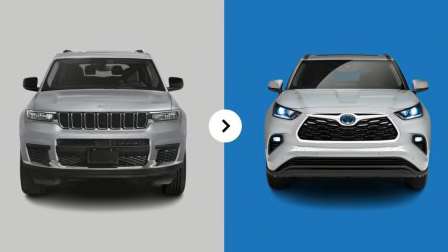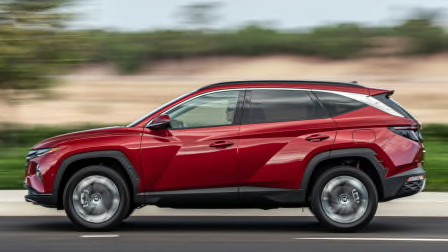Global Chip Shortage Makes It Tough to Buy Certain Cars
A major chip manufacturer says the shortage could stretch into 2023. CR offers expert advice on how to navigate the current car market.

The global semiconductor shortage continues to squeeze the supply of microchips used to manufacture everything from cars to robotic vacuum cleaners, and Intel’s CEO Pat Gelsinger said at the World Economic Forum in Davos, Switzerland, this spring that supply problems would most likely persist into 2024. That’s a revision of his earlier prediction that chip manufacturers would be able to bring production in line with demand by 2023.
Sam Abuelsamid, an analyst at Guidehouse Insights, which tracks the automotive industry, says the Taiwan Semiconductor Manufacturing Company (TSMC), one of the larger chip manufacturers, will be able to increase production capacity by the end of 2023. But efforts by other companies to beef up manufacturing may take longer, even stretching into 2024 and 2025.
Automakers, Abuelsamid says, are responding to the ongoing shortage in a variety of ways.
“In some cases, they are replacing short-supply chips with others that are more readily available, although that often requires software rewrites, testing, and revalidation,” he says. “In other cases, they are just deleting or limiting the availability of features until such time as chips are available.”
General Motors, for example, temporarily suspended seat heat on a number of its vehicles, although it promised to retrofit the feature when the necessary chips some in.
Despite high demand from consumers who needed cars, auto manufacturers built 1.7 million fewer vehicles in 2021 than in 2019, the last full year before the pandemic. And the war in Ukraine has disrupted the global supply of neon gas, which is used to make semiconductors. The myriad supply-side factors are causing automakers to pause production here and there, too.
“Dealers definitely seem to have more inventory than they did a year ago, but still nowhere near pre-pandemic levels,” Abuelsamid says. “It’s looking like this will continue well into 2023 at the very least. The content of semiconductors in vehicles is ever-increasing, and the shift to EVs is only going to exacerbate that.”
A tight supply of new cars means consumers can expect not to find deals—or even the exact cars they want, in some cases. Still, auto manufacturers have been directing available chip supply toward popular models.
For consumers, the best way to adapt to a still-challenging market is to plan ahead.
“If you anticipate needing a new car in the next six to 12 months, it’s probably best not to wait,” he says. “Go ahead and place a factory order now.”
Following that advice, he says, your car may arrive just in time.
“Odds are there won’t be much to choose from otherwise,” he says.
All new cars are built with a plethora of microchips onboard to control everything from window motors to navigation systems, and the auto manufacturing industry has been hard-hit as chip shortages have caused production slowdowns. For consumers hungry for new cars, that means fewer are available. Buying a car right now—whether new or used—is more difficult than usual.
So you have three choices: Look at models you weren’t previously considering, hold off on buying, or fix your old car if it’s in rough shape.
Jake Fisher, senior director of Consumer Reports’ Auto Test Center, recommends holding off until the market has shifted in the buyer’s favor. “Now is a tough time to buy a car, so it’s probably best to put it off if you can,” he says.
Why Semiconductors Are Important
Semiconductors are the metalloid elements used to make microchip processors, which are in turn used to make smartphones, televisions, internet routers, home climate control thermostats, and myriad other devices. Cars and trucks are now loaded with electronics, so they have them, too.
Abuelsamid says that every car has at least two or three dozen microprocessors, which control everything from infotainment screens to fuel management and stability control. Luxury vehicles and cars with high-tech equipment like advanced safety systems and driver assistance features may have 100 or more processors onboard, he says.
Manufacturers sold more than 14 million vehicles in the U.S. in 2020, and more than 17 million the year before, creating a need for hundreds of billions of microchips annually.
Even a couple of years after COVID-19 first rocked the world with shutdowns, pandemic-related factory closures and disruptions in consumer demand are still the main cause of the chip shortage. When automakers shut down factories in 2020—both to keep workers safe and to confront a steep drop in demand for new cars—they canceled orders for semiconductors.
At the same time, demand spiked for computers and other electronic devices because people needed to work and be entertained at home. When auto factories got rolling again and sales picked up in a big way toward the end of 2020, microchip manufacturers were unable to keep up with the surging demand.
To make matters worse, a major blizzard in Texas and a fire at a chip factory in Japan early in 2021 cut into an already strained semiconductor supply chain. And more recently, war in Ukraine has disrupted the supply of neon gas, which is used extensively in the semiconductor manufacturing process, Abuelsamid says. Ukraine supplies about 60 percent of the world’s neon.
“Chip suppliers say they have significant stockpiles of neon, so there may not be much short-term impact beyond the already existing shortages,” he says.
So where does that leave consumers? Abuelsamid says companies that haven’t supplied chips for the auto industry in the past are offering to help. And big chip manufacturers such as TSMC are building more factories.
But Abuelsamid says it will take more than a few months for chip manufacturers to bring their operations up to speed with the current demand for new cars. Making matters worse is the esoteric nature of the semiconductor industry, which faces its own supply bottlenecks as the handful of companies that supply equipment for their manufacturing facilities—known as fabs—race to meet increased demand on their end. Abuelsamid says it will take time for the improvements that semiconductor companies are making currently to have a noticeable impact on the supply of new cars.
“It’s likely that car buyers will be paying more for new vehicles, at least through 2022 and perhaps longer,” he says. “Most automakers are facing production cuts, which in turn means limited inventory of new products on dealer lots. Low inventory means reduced or nonexistent discounts and deals on new vehicles.”
Consequently, traditional discounts on the window sticker price have been harder to come by and have been typically smaller. In fact, Consumer Reports is seeing some cars sell well above the manufacturer’s suggested retail price.
CR members can refer to our monthly best new-car deals for guidance on models that perform well and have notable discounts. Insights on local transaction prices—key information for negotiating—can be found on the car model pages.
The silver lining is that now is a good time to sell a car if you’re not using it much because of the pandemic. Rising prices and reduced availability on new cars have pushed many consumers toward used cars, making them more scarce and more expensive as well, analysts say. In other words, it’s a seller’s market.




















